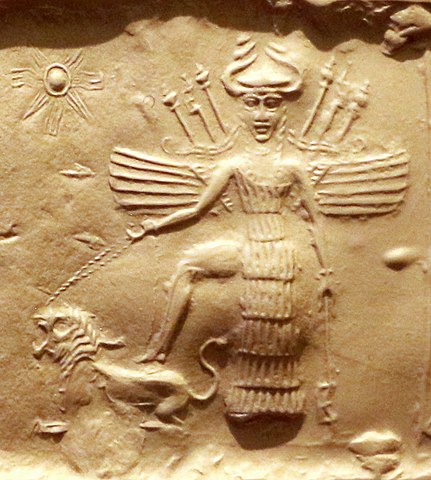Difference between revisions of "Template:Occult.live:Today's featured article"
Occultwiki (talk | contribs) |
Occultwiki (talk | contribs) |
||
| Line 1: | Line 1: | ||
[[File: | [[File:Ishtar Akkadian seal.jpg|200px|left]] | ||
'''[[Ishtar]]''' is the ancient goddess of love, war, and fertility worshipped in the Akkadian Empire, by the Babylonians, and Assyrians. She was originally worshipped in Sumer as Inanna. She is also associated with beauty, sex, divine law, and political power. Her primary title was "the Queen of [[Heaven]]." | |||
As early as the Uruk period (c. 4000–3100 bce), Inanna was already associated with the city of Uruk. During this period, the symbol of a ring-headed doorpost was closely associated with Inanna. The famous Uruk Vase (found in a deposit of [[cult]] objects of the Uruk III period) depicts a row of naked men carrying various objects, including bowls, vessels, and baskets of farm products, and bringing sheep and goats to a female figure facing the ruler. The female stands in front of Inanna's symbol of the two twisted reeds of the doorpost, while the male figure holds a box and stack of bowls, the later cuneiform sign signifying the ''En'', or high priest of the temple. | |||
'''([[ | '''([[Ishtar|Full Article...]])''' | ||
Revision as of 16:24, 5 August 2025
Ishtar is the ancient goddess of love, war, and fertility worshipped in the Akkadian Empire, by the Babylonians, and Assyrians. She was originally worshipped in Sumer as Inanna. She is also associated with beauty, sex, divine law, and political power. Her primary title was "the Queen of Heaven."
As early as the Uruk period (c. 4000–3100 bce), Inanna was already associated with the city of Uruk. During this period, the symbol of a ring-headed doorpost was closely associated with Inanna. The famous Uruk Vase (found in a deposit of cult objects of the Uruk III period) depicts a row of naked men carrying various objects, including bowls, vessels, and baskets of farm products, and bringing sheep and goats to a female figure facing the ruler. The female stands in front of Inanna's symbol of the two twisted reeds of the doorpost, while the male figure holds a box and stack of bowls, the later cuneiform sign signifying the En, or high priest of the temple.
